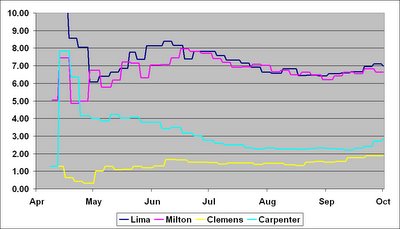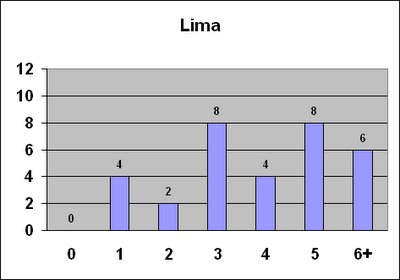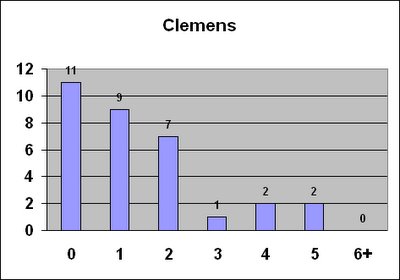Pitching deep into games is a good indicator of effectiveness. Check out how they match up.
|
| Inning Reached |
|
|
|
| Starts | 5 | 6 | 7 | 8 | 9 | Comp | IP |
|
| Lima | 32 | 23 | 16 | 6 | 3 | 1 | 1 | 168.2 |
|
| Milton | 34 | 29 | 20 | 10 | 2 | 0 | 0 | 186.1 |
|
| Clemens | 32 | 31 | 28 | 23 | 4 | 0 | 1 | 211.1 |
|
| Carpenter | 33 | 31 | 31 | 26 | 17 | 8 | 7 | 241.2 |
|
Lima Time didn't last very long in 2005. He made it past the fifth inning in only half of his starts, averaging a mere 5.27 per outing. He compiled only 168.2 innings despite 32 starts. That's the second-lowest total ever for a 32-start season with no relief appearances. Who beat him out?
Steve Cooke made it through only 167.1 innings in 32 starts for the 1997 Pirates. Who did Lima bump out of second place in that category? Why, Eric Milton! In 1998, the rookie Milton pitched only 172.1 innings in 32 starts for the Twins. And the most innings in a 32-start season (since WWII)? Why, it's Roger Clemens! In the same number of games as Lima, he threw 246.2 innings for Boston in 1992. To add insult to injury, in the only start in which Lima made it to the ninth, a
complete game 5-hitter on August 14, he still lost 1-0.
Milton, on the other hand, did make a little history here, becoming the reigning king in the 34-plus start category of Not-Even-Coming-Close-To-Finishing-What-You-Started. Since 1900 there have been 743 seasons in which a pitcher has started at least 34 games without a relief appearance. Of those, only 11 have failed to log at least 200 innings in the process. And only one didn't make it to 195 . And then along came Milton, who, in blowing past the immortal
Chuck Rainey, denies him his only claim-to-fame: an anemic 191 IP over 34 starts for the 1983 Cubs. Milton stomped all over Rainey with an even more unimpressive 186.1 IP. Who could have seen that coming? Well, actually, Milton narrowly escaped joining this club
just last year, compiling only 201 innings in his 34 starts, good for 50th place in innings per start amongst 2004's 57 30-plus-game starters. But that didn't stop Cincinnati from giving him more than
$25 million!
Clemens was an interesting case. He had pretty good staying power, averaging 6.60 innings each time on the mound. But what makes that impressive--unbelievable, actually--is that he only got to the eighth
four times! That's only one more time than Lima. He apparently had a predictable tiring point: he pitched
exactly 7 innings in 19 of his 32 starts. Verrry interesting...
Carpenter was the workhorse. He pitched 73 more innings than Lima despite making only one more start than him, and 55.1 innings more than Milton despite making one
fewer start. He reached the eighth an amazing 25 times as opposed to Milton's...um...two. His 241.2 innings is the most in a 33-start, no relief season since
Charles Nagy logged 252 IP in 1992. And Carpenter's 7.47 innings per start is the most since
Randy Johnson's amazing 7.76 mark in his memorable 364-strikeout 1999 campaign.
Tune in next time for some ERA fun.
Extra EsotericaHow about this for a contrast: In 1982, Bob Stanley averaged 3.51 innings per appearance in 48 games without a start. Yes, that's a record by far. He threw an amazing, only-topped-by-inhuman-Mike-Marshall 168.1 innings in relief, just about the same number as starter Lima. And each time out there, Lima, on average, got only 5 more outs than Stanley!





